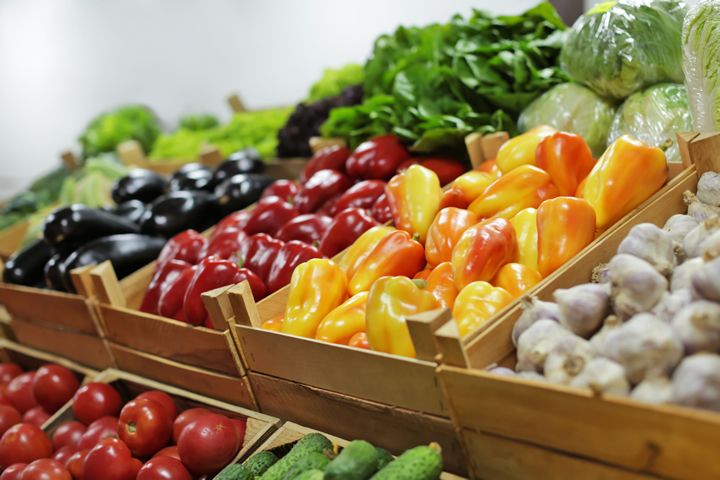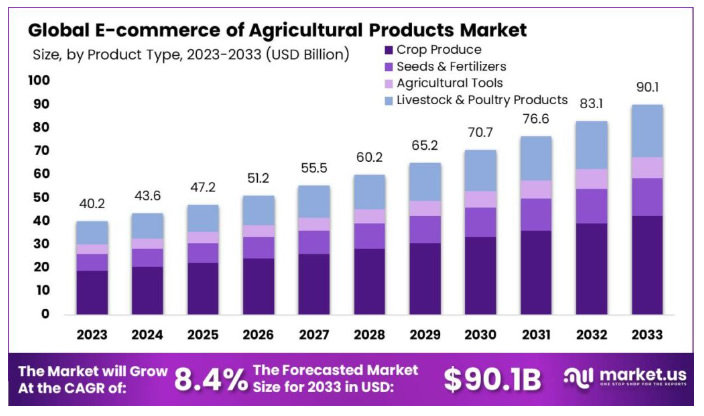Technological innovations like mobile platforms, blockchain, and AI are playing a crucial role in overcoming barriers, making it possible for stakeholders to engage more effectively in the agricultural value chain.
 E-commerce of Agricultural Products Market: Pioneering the Digital Transformation of Agriculture
E-commerce of Agricultural Products Market: Pioneering the Digital Transformation of Agriculture

Mr. Yogesh Shinde, ICT Manager | Market.us
E-commerce of agricultural products refers to the online buying and selling of agricultural goods, such as crops, livestock, and other farm-produced products. This digital marketplace provides farmers with a platform to reach a broader customer base, bypassing traditional middlemen and physical market constraints. It offers an efficient, scalable, and cost-effective solution for farmers and agribusinesses to market their produce directly to consumers, retailers, and other businesses. With the integration of advanced technologies like mobile apps, AI for inventory and supply chain management, and real-time data analytics, e-commerce platforms are revolutionizing the agricultural sector.
According to Market.us, The E-commerce of Agricultural Products Market is projected to reach USD 90.1 billion by 2033, with a CAGR of 8.4% from 2024 to 2033. The e-commerce of agricultural products market is a dynamic sector that connects farmers and producers directly with consumers and businesses through online platforms. This trend has been significantly driven by the increasing penetration of internet services and smartphones, coupled with a growing consumer preference for fresh, organic, and locally sourced food. These platforms not only simplify the selling and buying process but also improve supply chain transparency, providing real-time data on pricing, availability, and origin of produce.
Demand for E-commerce in Agricultural Products
The market is seeing innovative solutions, including integrated supply chains and enhanced logistics, tailored specifically for perishable goods and rural markets. The demand for e-commerce in agricultural products is surging as consumers increasingly seek convenience, variety, and quality in their food purchases. This sector is particularly supported by urban consumers who are more inclined towards organic and health-conscious diets but face limited access to fresh farm produce. Additionally, the ongoing global health crisis has accelerated the shift towards online shopping, further bolstering the demand. Farmers, on the other hand, benefit from direct access to larger markets and fairer prices, bypassing traditional middlemen. Technological advancements such as mobile apps and improved online payment systems also fuel this growing demand.

Growth of the E-commerce of Agricultural Products Market
The growth of this market is robust, driven by technological advancements and increasing investments in agri-tech startups. E-commerce platforms specializing in agricultural products are expanding their reach through partnerships with local farmers and cooperatives, enhancing their logistics networks to handle fresh goods efficiently. The integration of AI and data analytics into these platforms allows for better demand forecasting and inventory management, reducing waste and improving the freshness of delivered goods. Governments are also playing a crucial role by providing infrastructure support and regulatory frameworks that encourage online transactions in rural areas.
Opportunities in the E-commerce of Agricultural Products Market
The market presents significant opportunities, including the potential to empower rural farmers and contribute to more sustainable agricultural practices. By reducing the number of intermediaries, e-commerce platforms can help increase profit margins for farmers and decrease market inefficiencies. There's also a growing trend towards vertical integration, where e-commerce platforms start to invest in agricultural production itself to ensure quality and supply stability.
Furthermore, the expansion into international markets offers another lucrative avenue for growth, particularly in regions where there is a high demand for exotic or specific regional products. The continual development of better logistical solutions and more user-friendly platforms will also be key in realizing these opportunities.
E-commerce of Agricultural Products Statistics
-
The E-commerce of Agricultural Products Market is projected to reach USD 90.1 billion by 2033, with a CAGR of 8.4% from 2024 to 2033.
-
In 2023, the Crop Produce segment emerged as the dominant product category, capturing over 47.1% of the market share. This growth is primarily driven by the rising global demand for fresh and high-quality food products.
-
The Business-to-Business (B2B) model also dominated in 2023, accounting for over 52.5% of the market share. B2B platforms are preferred due to their benefits, such as bulk ordering and customized pricing, which cater to the specific needs of businesses.
-
Geographically, North America held a leading position in 2023, with a market share exceeding 38.7%. This dominance can be attributed to the region's well-developed digital infrastructure, high adoption of technology, and the growing trend of direct-to-consumer sales.
-
Key players in the E-commerce of Agricultural Products Market include Amazon.com, Alibaba Group, JD.com, and Walmart Inc. These companies play a significant role in shaping the industry landscape.
Emerging Trends in E-commerce of Agricultural Products
-
Direct-to-Consumer Platforms: Increasingly, farmers are utilizing e-commerce platforms to sell directly to consumers, bypassing traditional middlemen. This approach boosts their profit margins and lowers costs for buyers.
-
Subscription Models: There's a rise in subscription-based models for regular deliveries of fresh produce, which provide a steady demand for farmers and convenience for consumers.
-
Integration of Blockchain: The adoption of blockchain technology is growing to enhance traceability and transparency in the agricultural supply chain, giving consumers confidence in the quality and origin of their purchases.
-
Mobile Technology Proliferation: With the widespread adoption of smartphones, mobile platforms are increasingly favored for buying and selling agricultural products, thus broadening market access.
-
Use of Big Data and IoT: The application of IoT and big data in agriculture is revolutionizing farming practices by enabling precise data-driven decision-making, from crop performance analytics to climate pattern analysis.
Top Use Cases for E-commerce of Agricultural Products
-
Direct Sales by Farmers: Farmers list their products online where consumers can purchase them directly, thus eliminating the need for physical marketplaces and reducing dependence on intermediaries.
-
Precision Agriculture Tools: Online platforms provide advanced tools that use data analytics for better crop management, helping to predict yields and optimize farming practice.
-
Community-Supported Agriculture (CSA): Consumers pre-pay for a portion of the harvest, receiving fresh agricultural products periodically. This model offers farmers upfront capital and ensures a dedicated market.
-
E-commerce for Agricultural Inputs: Farmers can purchase necessary inputs like seeds and fertilizers directly through online platforms, often at more competitive prices than traditional retail outlets.
-
Global Market Access: E-commerce enables farmers to access international markets, expanding their customer base far beyond local and national boundaries, thus maximizing their market exposure and revenue potential.
Major Challenges in E-commerce of Agricultural Products
-
Digital Infrastructure Limitations: In many rural areas, the lack of robust internet connectivity and digital infrastructure significantly hinders the adoption and effective operation of e-commerce platforms for agricultural products.
-
Low Digital Literacy: Many farmers and smallholders lack the necessary digital skills to engage effectively with e-commerce platforms, limiting their ability to benefit from online agricultural marketplaces.
-
Financial and Payment Issues: Access to financial services and efficient digital payment systems remains a challenge, particularly in less developed regions. This restricts the ability of farmers to conduct transactions smoothly on e-commerce platforms.
-
Supply Chain and Logistics Challenges: Efficiently managing logistics and supply chain operations from rural areas to markets is complex and costly, especially for perishable goods.
-
Regulatory and Policy Barriers: Inconsistent regulations and a lack of clear policies related to e-commerce in agriculture create uncertainties that can deter investment and innovation in this sector.
Technological Innovations in E-commerce of Agricultural Products
-
Mobile and Cloud-based Platforms: The development of mobile applications and cloud-based solutions has made it easier for farmers to manage inventory, process orders, and reach customers.
-
Blockchain for Traceability: Implementing blockchain technology helps in creating transparent supply chains, where consumers can trace the origin of their purchased products, enhancing trust and accountability.
-
IoT and Smart Farming: Internet of Things (IoT) devices are being integrated to monitor crops and livestock, predict yields, and optimize resource use, which in turn supports e-commerce activities by ensuring product quality and availability.
-
Big Data Analytics: Leveraging big data helps in understanding market trends, consumer preferences, and pricing strategies, which can be used to enhance marketing efforts on e-commerce platforms.
-
AI and Machine Learning: Artificial intelligence and machine learning are being employed to personalize shopping experiences, predict demand, and manage stocks more efficiently in agricultural e-commerce.
Conclusion
E-commerce in the agricultural sector represents a transformative shift towards digitalization with the potential to enhance market access and improve the livelihoods of farmers. However, challenges such as insufficient digital infrastructure, low digital literacy among farmers, and logistical hurdles still need to be addressed to fully leverage this potential. Technological innovations like mobile platforms, blockchain, and AI are playing a crucial role in overcoming some of these barriers, making it possible for stakeholders to engage more effectively in the agricultural value chain.
As these technologies continue to evolve and adapt to the needs of the agricultural sector, they promise to further bridge gaps between farmers and markets, offering enhanced efficiency and greater economic opportunities. This evolution necessitates continued investment and policy support to ensure that the benefits of agricultural e-commerce are realized across all levels of the supply chain.
Mr. Yogesh Shinde is ICT Manager at Market.us. He oversees a comprehensive portfolio of ICT products and solutions, including network infrastructure, cybersecurity tools, cloud services, data center solutions, telecommunications equipment, software-defined networking (SDN), and Internet of Things (IoT) devices. With a focus on driving digital transformation and enhancing connectivity, Yogesh ensures that the company's offerings meet the evolving needs of both industrial and commercial sectors. His expertise in information and communication technology is instrumental in delivering innovative and reliable solutions to clients worldwide.
The content & opinions in this article are the author’s and do not necessarily represent the views of AgriTechTomorrow
Comments (0)
This post does not have any comments. Be the first to leave a comment below.
Featured Product

